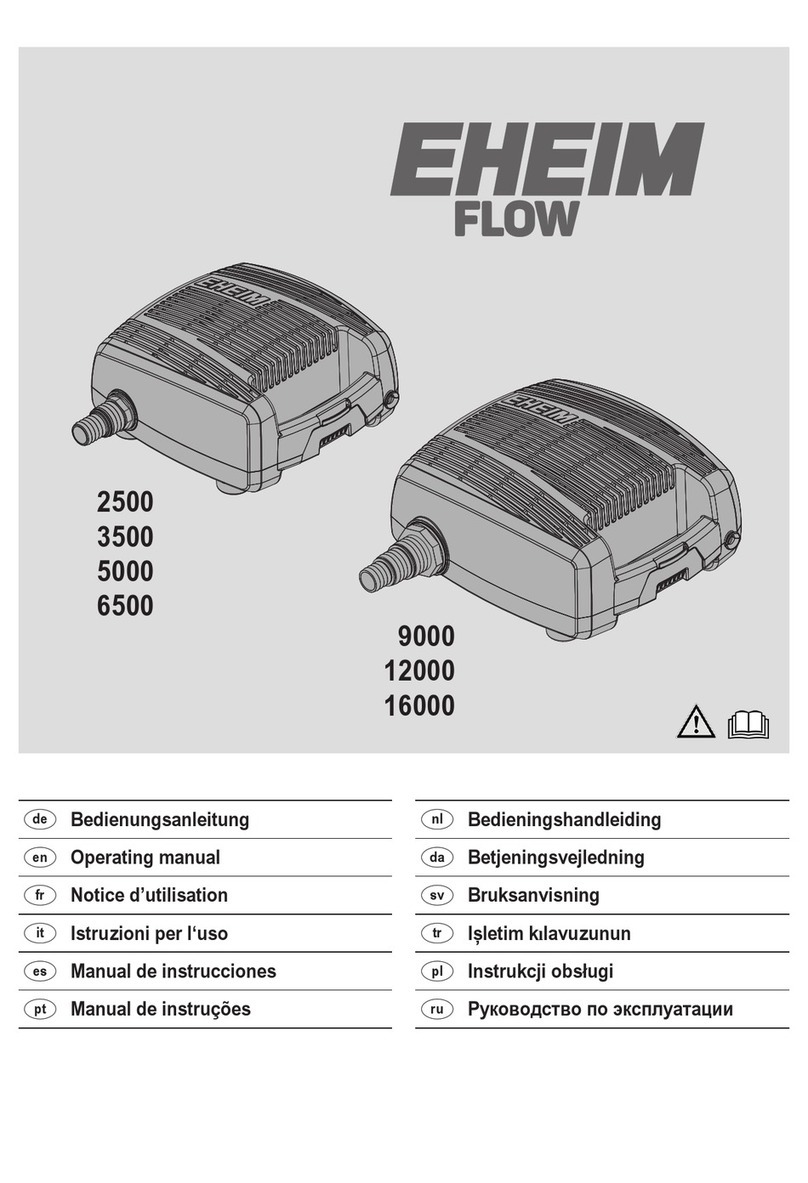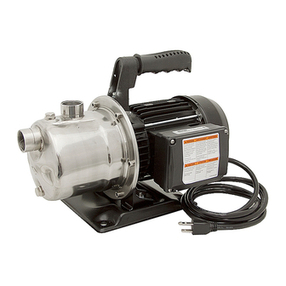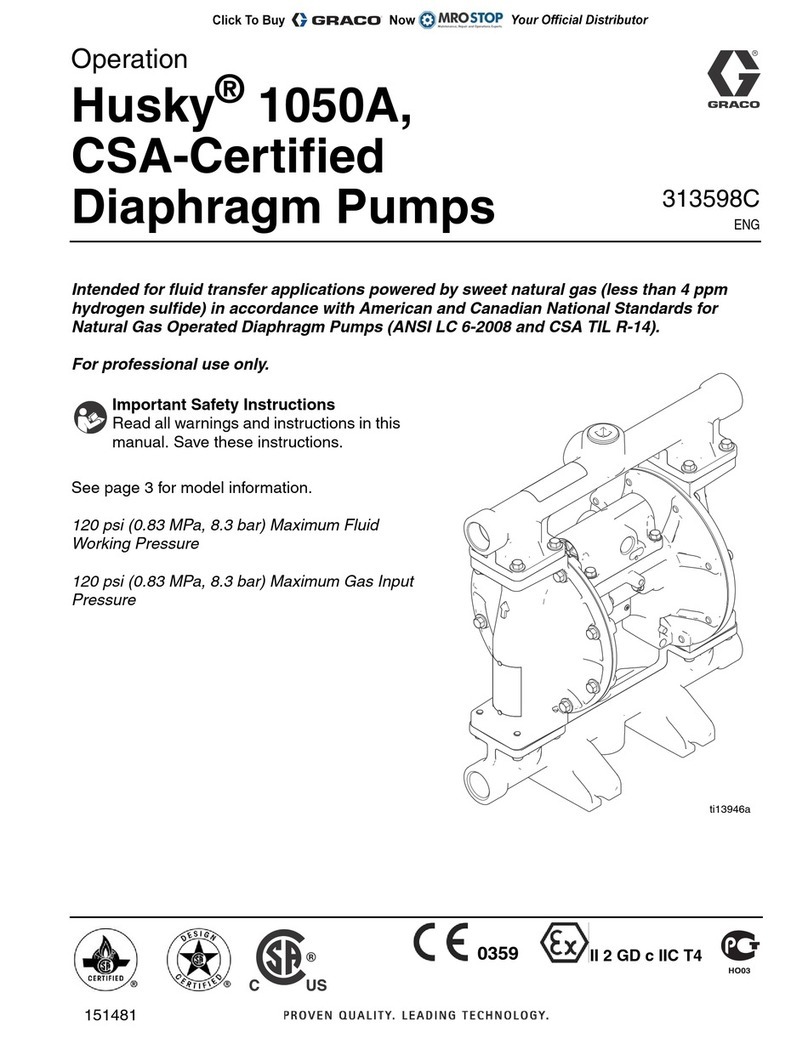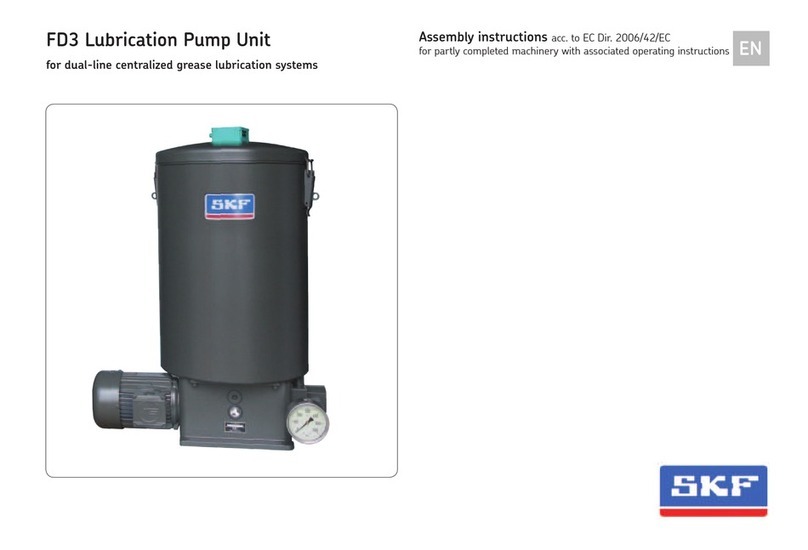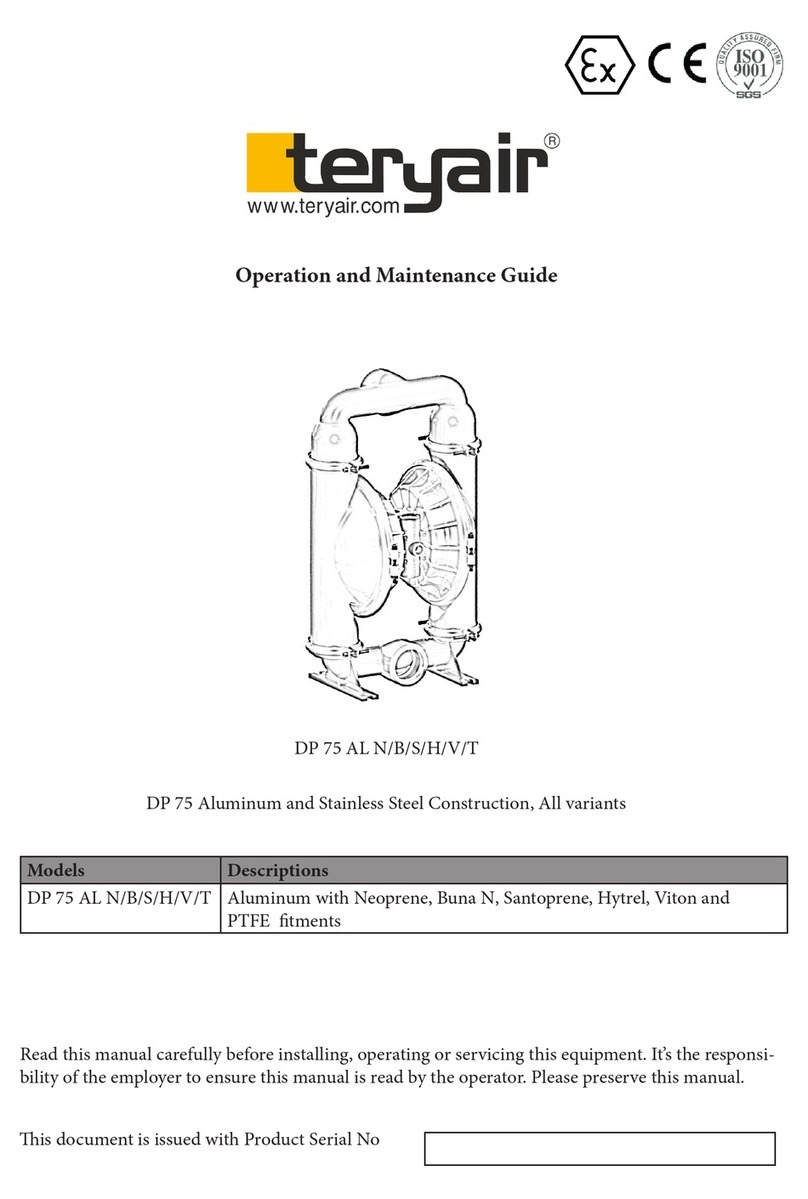battioni Pagani MEC Series User manual

pag. 30
instruction manual
for use and maintenance serie MEC, STAR, AGRI
Battioni Pagani®
INTRODUCTION
The Rotary blades vacuum pumps Battioni Pagani®have been designed and constructed in compliance with EEC safety regulations
and have been assessed for risks according to standard UNI EN ISO 12100:2010; in particular they are in conformity with directive
2006/42/CE and subsequent modications and additions.
Since the design of this pump complies with the denition of a machine as contained in the Machinery Directive 2006/42/EC, the
pump bears the CE mark on its identication plate. However, it must be pointed out that because of its application and the purpose
for which it is supplied, which species that it be installed by the buyer (without motive power), Battioni Pagani® refuses any and
all responsibility if the instructions in this operation and maintenance manual are not followed.
This manual contains the Declaration of CE conformity and all the instructions required by users, and by the manufacturers of plant
systems, for using our products safely. As a result, the manual must always be kept near the rotary blades vacuum pump.
The descriptions and illustrations in this manual are purely indicative.
The manufacturer reserves the right to make any type of change to this manual at any time.
GUARANTEE
At the moment of receiving the Rotary blades vacuum pump check that it is complete with all its parts.
Any anomalies or missing parts must be notied within 8 days of receipt of the product.
The Supplier guarantees that the product sold is free from defects and undertakes to repair or, by nal decision, to replace the faulty
parts only if the defects are clearly attributed to the manufacturing process or to the materials used. In any case the costs of labour,
travel and transport, and any customs expenses shall be paid by the Purchaser. The vendor is not obliged to pay damages except in
the case of fraud or grave offence. All parts subject to normal wear are excluded from the guarantee. The guarantee will cease to be
valid if:
• the faults reported are the result of accidents or obvious carelessness or negligence on the part of the Purchaser,
• the parts have been modied, repaired or tted by persons not authorised by the vendor,
• the failures and breakages have been caused by use that is unsuitable or heavier than that provided for by the vendor,
• the Purchaser has failed to make the payments as agreed by contract.
The Purchaser loses his/her right to the guarantee if he/she fails to report the defects to the vendor within 8 days of discovery,
making an exception to article 1512 of the Italian Civil Code. The Vendor reserves the right to make changes or improvements to
his/her products without being obliged to make the same changes or improvements to the units already produced and/or delivered
previously. The Vendor is not responsible for accidents or for the effects of accidents to people or property due to defective materials
and/or workmanship.
Thank you for choosing Battioni Pagani®.
This danger symbol in the manual means that important safety instructions are given. This information is
destined primarily for the operator whose responsibility it is not only to comply with them personally, but also
to ensure compliance by other persons exposed to the connected risks.

ENGLISH
pag. 31
instruction manual
for use and maintenance serie MEC, STAR, AGRI
OBLIGATORY SAFETY SIGNS TO BE DISPLAYED IN THE WORK PLACE
AND IN THE VICINITY OF THE ROTARY BLADES VACUUM PUMP
CONDITIONS AND LIMITS OF USE – LIST OF DANGERS
In the Common Market countries, the installation must comply with directive 2006/42/CE and subsequent modications,
while in the other countries it must comply with the safety regulations of the country.
This Rotary blades vacuum pump has been designed to create a vacuum or pressure inside a tank connected to it.
Under no circumstances must liquids, dust or any kind of solid matter enter the Rotary blades
vacuum pump because they could cause it to break. Therefore it is necessary to equip the system
with safety valves.
The use of the Rotary blades vacuum pump for any purpose other than that specied above is
absolutely forbidden, not provided for by the manufacturer and therefore highly dangerous.
Do not use the Rotary blades vacuum pump to handle ammable and/or explosive liquids and
materials or for materials that give off ammable gasses.
Read This Manual Before Using The Suction Unit/Compressor
Do not use the rotary blades vacuum pump in a potentially explosive atmosphere.
Never remove the guards tted on the Rotary blades vacuum pump and always check their
efciency every time the machine is used.
Any work on the machine must be carried out while it is not running.
Failure to comply with the instructions given in this manual may lead to the following dangers:
• Danger of being crushed by the Rotary blades vacuum pump mass during handling and transport;
• Danger of getting entangled in the shaft transmission parts if the necessary guards are removed;
• Heat dangers due to the temperatures that can be reached by the Rotary blades vacuum pump;
• Acoustic danger due to the noise generated and to failure to use personal means of protection;
• Danger to operator’s hands during testing with suction and delivery tubes detached from the pump;
• Danger of abrasion from the shaft of the hydraulic pump support if the Rotary blades vacuum pump is operated
with the hydraulic pump removed;
• Danger of projection of uid and solid materials owing to an heavy breakage of the Rotary blades vacuum pump.
INDIVIDUAL MEANS OF
PROTECTION THAT IT
IS OBLIGATORY TO USE
DIRECTION OF ROTATION OF THE
HANDLE TO SELECT SUCTION OR
COMPRESSION PHASES
MOVING
PARTS
HIGH
TEMPERATURE
DANGER
OF CRUSHING
READ THIS MANUAL
BEFORE STARTING
TO USE THE ROTARY
BLADES VACUUM PUMP
MAINTENANCE
TO BE
CARRIED OUT
DO NOT ENTER THE WORKING
AREA OF THE MOVING CARDAN
SHAFT. AVOID WEARING WORK
CLOTHES WITH PARTS OR
FLAPS THAT COULD GET
HOOKED UP

pag. 32
instruction manual
for use and maintenance serie MEC, STAR, AGRI
SUMMARY
INTRODUCTION.......................................................................................................................................................................................30
GUARANTEE............................................................................................................................................................................................ 30
OBLIGATORY SAFETY SIGNS TO BE DISPLAYED IN THE WORK PLACE AND IN THE VICINITY OF THE
ROTARY BLADES VACUUM PUMP...........................................................................................................................................................31
CONDITIONS AND LIMITS OF USE – LIST OF DANGERS.........................................................................................................................31
SUMMARY ..............................................................................................................................................................................................32
GENERAL INFORMATION ........................................................................................................................................................................34
1 - VERSIONS OF THE ROTARY BLADES VACUUM PUMP ...............................................................................................................34
1.1 IDENTIFICATION LABEL ..............................................................................................................................................................35
INSTRUCTIONS FOR USE AND MAINTENANCE....................................................................................................................................... 36
2 - PACKAGING, STORAGE, HANDLING AND TRANSPORT...............................................................................................................36
2.1 PACKAGING .................................................................................................................................................................................36
2.2 STORAGE ....................................................................................................................................................................................36
2.3 HANDLING AND TRANSPORT........................................................................................................................................................ 36
3 - ASSEMBLY, FITTING, INSTALLATION, DISASSEMBLY, RE-FITTING.............................................................................................36
3.1 INSTALLATION DRAFT..................................................................................................................................................................36
3.2 DOUBLE OUTLET INSTALLATION DRAFT.......................................................................................................................................37
3.2.1 DIAGRAM OF INSTALLATION WITHOUT MANIFOLD ON IRRIGATION MACHINES ..............................................................................9
3.3 ASSEMBLY AND FITTING - INSTALLATION ....................................................................................................................................37
3.4 HYDRAULIC PLAN ( /H VERSION) ..................................................................................................................................................38
3.5 INSTRUCTIONS FOR USE AND MAINTENANCE OF HYDRAULIC MOTOR ........................................................................................ 39
3.6 DISINSTALLATON.........................................................................................................................................................................41
3.7 DISASSEMBLY .............................................................................................................................................................................41
3.7.1 Back disassembly ..............................................................................................................................................................41
3.7.2 Front disassembly.............................................................................................................................................................. 42
3.8 RE-FITTING – RE-INSTALLATION..................................................................................................................................................42
3.8.1 Re-tting of the back .........................................................................................................................................................42
3.8.2 Re-tting of the manifold ...................................................................................................................................................43
3.8.3 Re-tting of the front.......................................................................................................................................................... 44
3.8.4 Correct positioning of reversing gear .................................................................................................................................44
4 - DIRECTION OF ROTATION INVERSION .......................................................................................................................................45
5 - START-UP ..................................................................................................................................................................................45
5.1 OPERATION WITHOUT OVER-PRESSURE VALVE (ONLY MEC SERIES)..............................................................................................45
5.2 DIRECTION OF ROTATION.............................................................................................................................................................45

ENGLISH
pag. 33
instruction manual
for use and maintenance serie MEC, STAR, AGRI
6 - SET-UP OF THE LUBRICATION SYSTEM .....................................................................................................................................46
6.1 NORMAL LUBRICATION................................................................................................................................................................ 46
6.2 FORCED LUBRICATION................................................................................................................................................................ 46
6.3 AUTOMATIC LUBRICATION ..........................................................................................................................................................46
6.4 OIL TO USE.................................................................................................................................................................................. 46
6.4.1 Absolutely, do not use following oil brands ........................................................................................................................46
6.4.2 Gearbox oil ........................................................................................................................................................................ 47
6.5 OIL LEVEL....................................................................................................................................................................................47
6.6 QUANTITY OF LUBRICATION OIL................................................................................................................................................... 48
6.7 REGOLATION FOR LUBRICATING OIL ............................................................................................................................................49
7 - OVERPRESSURE AND VACUUM ADJUSTMENT VALVES.............................................................................................................49
8 - TESTING AND RUNNING IN ........................................................................................................................................................50
8.1 TESTING...................................................................................................................................................................................... 50
8.2 RUNNING IN ................................................................................................................................................................................ 50
9 - START, OPERATION, STOP..........................................................................................................................................................51
9.1 START .......................................................................................................................................................................................51
9.2 OPERATION ................................................................................................................................................................................. 51
9.3 STOP .......................................................................................................................................................................................52
9.4 CONTROLS .................................................................................................................................................................................52
9.5 PROTECTIVE DEVICES.................................................................................................................................................................. 52
9.6 PROTECTIVE DEVICES.................................................................................................................................................................. 52
9.7 INDIVIDUAL MEANS OF PROTECTION TO BE USED .......................................................................................................................52
10 - TROUBLESHOOTING ...................................................................................................................................................................53
11 - MAINTENANCE, INSPECTIONS AND CHECKS, REPAIRS, TECHNICAL ASSISTANCE...................................................................54
11.1 CLEANING ...................................................................................................................................................................................54
11.1.1 Washing of the body .......................................................................................................................................................54
11.1.2 Washing of oil tank .........................................................................................................................................................54
11.1.3 Washing and cleaning of valves ......................................................................................................................................54
11.2 CHECKING OF VALVES..................................................................................................................................................................54
11.3 INSPECTION AND REPLACEMENT OF Blades ................................................................................................................................54
11.3.1 General information on blades ........................................................................................................................................ 54
11.3.2 Inspection of blades........................................................................................................................................................ 55
11.3.3 Replacement of blades ...................................................................................................................................................55
11.3.4 Blades dimensions..........................................................................................................................................................56
11.4 REPLACEMENT OF RUBBER BALL................................................................................................................................................ 56
11.5 REPLACEMENT OF GEARS (VERSION / M - MA / K - KA) ...............................................................................................................56
11.6 TECHNICAL ASSISTANCE .............................................................................................................................................................57
11.7 REGULAR SERVICING...................................................................................................................................................................57
12 - PUTTING OUT OF SERVICE AND DEMOLITION ...........................................................................................................................57
SPARE PARTS ...................................................................................................................................................254
TECHNICAL DATA ..............................................................................................................................................305

pag. 34
instruction manual
for use and maintenance serie MEC, STAR, AGRI
GENERAL INFORMATION
1 - VERSIONS OF THE ROTARY BLADES VACUUM PUMP
The Rotary blades vacuum pump can be supplied in the following versions:
SERIE MMA P D H K KA GGA
MEC 1000/1600 O - O - - - - - -
MEC 2/3/4000 O - O O O - - O O
MEC 5/6.5/8000 O - O O O - - O O
MEC 9/11/13500 O O O O O - - O O
STAR 60-72-84 OOO O OOOOO
AGRI 60-72-84 OOO O OOOOO
- Not available O Available
…/ M VERSION–…/MA VERSION (with gearbox)
• …/Mthe power take-off is actuated through a cardan shaft
at 540 r.p.m. This version can be recognised by the gearbox
placed at the front of the Rotary blades vacuum pump and by
the identication plate.
• … / MA the power take-off is actuated through a cardan shaft
at 1000 r.p.m. This version can be recognised by the gearbox
placed at the front of the Rotary blades vacuum pump, by the
identication plate and by the punching placed on the upper
part of the gearbox.
…/ P VERSION (for pulley application)
• …/Pthe power take-off is actuated through a pulley and
belts. This version can be recognised by the cylindrical shaft
with key of the power take off and by the plate, …/P pulley
application.
…/ D VERSION (direct drive)
• … / D the power take-off is actuated through a cardan shaft
directly connected to the splined hub. This version can be
recognised by the splined hub placed at the front of the Rotary
blades vacuum pump and by the identication plate, …/D
direct drive
…/H VERSION (for hydraulic drive)
• …/Hthe power take-off is actuated through a gears hydraulic
motor. This version can be recognised by the hydraulic motor
support placed at the front and by the identication plate,
…/H hydraulic drive.
ANTICLOCK
WISE
CLOCK
WISE
ANTICLOCK
WISE
CLOCK
WISE
ANTICLOCK
WISE
ON REQUEST
CLOCK WISE
ON REQUEST

ENGLISH
pag. 35
instruction manual
for use and maintenance serie MEC, STAR, AGRI
Versions… /K and … /KA have been designed so that they can be used to actuate the hydraulic accessories (gate valves, draft
tube, support base etc.) on the tank car because in many cases the hydraulic pump on the tractor does not have sufcient oil ow
rate for all the movements. With this application all the work may be carried out from the tractor cabin by operating only one
distributor
All the versions of the STAR and AGRI series of Rotary blades vacuum pump can be supplied with back tank in cast iron (versions /MV, /
MAV, /PV, /DV, /HV, /KV /KAV) or with extractable side tank in sheet metal (versions /MF, /MAF, /PF, /DF, /HF, /KF, /KAF).
1.1 IDENTIFICATION LABEL
Every rotary blades pump is supplied with an identication label stating:
- rotary blades pump model
- serial number
- production year
- max relative pressure
- max vacuum
- max absorbed power
- max r.p.m.
- max rate of ow
- CE mark
- weight of pump
ANTICLOCK
WISE
…/ K VERSION –…/KA VERSION (with gearbox and hydraulic pump support)
• … / K the power take-off is actuated through a cardan shaft
at 540 rpm and is designed to actuate an hydraulic pump of
group 2 or group 3. This version can be recognised by the
hydraulic pump support and by the identication plate.
•… / KA the power take-off is actuated through a cardan shaft
at 1000 rpm and is designed to actuate an hydraulic pump of
group 2 or group 3. This version can be recognised by the
hydraulic pump support, by the identication plate and by the
punching placed on the upper part of the gearbox.
CLOCK
WISE
…/ G VERSION –…/GA VERSION (application for GARDA or LEDRA)
• … / G version of Rotary blades vacuum pump that is applied
on the GARDA or the LEDRA group; it cannot be used on its
own. This version can be recognised by the external pinion
placed at the front of the Rotary blades vacuum pump and by
the identication plate.
• … / GA version of Rotary blades vacuum pump that is
applied on the GARDA or the LEDRA group at 1000 rpm;
it cannot be used on its own. This version can be recognised
by the external pinion placed at the front of the Rotary blades
vacuum pump and by the identication plate.
Every identication plate is protected by a
special sky-blue colour lm, to remove after
painting.
This lm has been introduced to guarantee the
tracing of the pump for warranty purposes.
IDENTIFICATION LABEL WITH PROTECTIVE FILM
FOR PAINTING

pag. 36
instruction manual
for use and maintenance serie MEC, STAR, AGRI
985 3
7 6
1
24
7
9 8 5 3
4 2
7
76
1
3.1 INSTALLATION DRAFT
INSTRUCTIONS FOR USE AND MAINTENANCE
2.0 - PACKAGING, STORAGE, HANDLING AND TRANSPORT
2.1 PACKAGING
The Rotary blades vacuum pump are supplied without packaging. On request the following packaging can be used:
• wooden base and shrink-wrap;
• wooden cases and shrink-wrap for shipment by sea or air.
2.2 STORAGE
In order to preserve the Rotary blades vacuum pump correctly, it must be stored:
• under cover, sheltered from adverse weather conditions;
• resting horizontally on its four feet.
The Rotary blades vacuum pump are lubricated during testing at our factory with special oil that ensures lubrication of the various
internal components for approx. 6 months.
In the event of subsequent storage it is advisable to wash the inside of the body with oil and diesel oil (as stated on this manual).
2.3 HANDLING AND TRANSPORT
Mass of Rotary blades vacuum pump: (see tecnical sheet).
The Rotary blades vacuum pump should be:
• Harnessed by means of metal hooks inserted in the hole for gripping, or a sling;
• Lifted with a hoisting truck (if on pallet), bridge crane, or crane.
• MEC 1000/1600 pumps must be lifted through a 1/4” gas eyebolt that has to be tted instead of drain cock.
The Rotary blades vacuum pump is supplied with a guard that is in compliance with EC directives. This guard should be tted on by
the tter using the four screws supplied.
3.0 - ASSEMBLY, FITTING, INSTALLATION, DISASSEMBLY, RE-FITTING
The procedures concerning Rotary blades vacuum pump versions …/G and …/GA are given in the GARDA/LEDRA group
instructions.
All maintenance operations, inspections, checks and repairs should be carried out with the greatest care and with
the tractor not running and the power take-off disconnected.
It is essential to prevent sewage from entering the Rotary blades vacuum pumps. The entrance of sewage would
cause the blades and consequently the rotor to break.
It is therefore necessary to equip the system with an overow valve, “3”, and a safety overow valve, “2”, between
the Rotary blades vacuum pump and the tank car (see Figure 1)
When carrying out maintenance operations, inspections, checks and repairs you are advised to wear the individual
means of protection listed in this manual.
Figure 1
1 - Pump
2 - Secondary shut-off valve
3 - Primary shut-off valve
4 - Silencer
5 - Motorized joint
6 - Swivel joint
7 - Stemgate
8 - Overpressure valve
9 - Depression valve

ENGLISH
pag. 37
instruction manual
for use and maintenance serie MEC, STAR, AGRI
3.2 DOUBLE OUTLET INSTALLATION DRAFT
The Rotary blades vacuum pump can be used as a mixer
by tting, on request, a double outlet on the manifold (see
Figure 2). In this case there will be the intake of a normal
Rotary blades vacuum pump, but a perforated tube placed
inside the tank car must be used for the compression.
When the handle is positioned on the compression phase, the
air will be forced out through the holes in the tube so causing
mixing of the previously loaded sewage (never exceed the
maximum working absolute pressure of 2,5 bar) equal to 1,5
relative bar.
Figure 2
With this system, a check valve (1) must be tted on the delivery tube to prevent the transfer of sewage inside the
Rotary blades vacuum pump.
3.3 ASSEMBLY AND FITTING - INSTALLATION
The Rotary blades vacuum pump should be assembled and installed using the following procedure:
1) Assemble the Rotary blades vacuum pump horizontally with its feet facing downwards. The assembly position on the vehicle
should be easy to access and be protected. A 5° maximum longitudinal slope of the Rotary blades vacuum pump with respect to the
horizontal plane must not be exceeded.
2) Bolt the Rotary blades vacuum pump using screws and nuts passing through the specially provided slots or holes in the feet;
3-M/K) To install the …/M-K version Rotary blades vacuum pump, connect the cardan shaft at 540 r.p.m.of the tractor to the P.T.O.
shaft of the Rotary blades vacuum pump.
3-MA/KA) To install the …/MA-KA version Rotary blades vacuum pump, connect the cardan shaft at 1000 r.p.m.of the tractor to
the P.T.O. shaft of the Rotary blades vacuum pump.
Don’t exceed the maximum slope allowed for the cardan shaft.
1
Suction
Compression
Battioni Pagani® produces a complete line of rotary blades vacuum pumps
for use on irrigation machines.
To use the rotary pump correctly, the irrigation machine must be completely
lled with water and must not be partially empty.
Important: never exceed the relative maximum operating pressure
of 3.5 bar.
With this system, the delivery pipe must be equipped with a
check valve (1) to prevent water from backing up into the
rotary blades vacuum pump.
3.2.1 DIAGRAM OF INSTALLATION WITHOUT MANIFOLD ON IRRIGATION MACHINES
1
1 - Pump
2 - Secondary shut-off valve
3 - Primary shut-off valve
4 - Silencer
5 - Motorized joint
6 - Swivel joint
7 - Stemgate
8 - Overpressure valve
9 - Depression valve

pag. 38
instruction manual
for use and maintenance serie MEC, STAR, AGRI
Max
Section Min
Kg. Kg.
A 0,68 1,02
B1,58 2,38
C2,93 4,75
D 5,77 8,61
E9,60 14,30
Force
Lenght of deection
Lenght of
that free
Force (Td)
3-P) To install the …/P version Rotary blades vacuum pump, attach a driven pulley to the shaft and x it with the special screw
located on the front of the shaft. The driven pulley may be tted directly on the cylindrical shaft if the radial load is brought close to
the bearing. Never transfer axial loads. Then connect the driven pulley to the driving pulley with the correct length of driving belts.
The number and type of belts must be calculated according to the power to be transferred to the Rotary blades vacuum pump. When
this operation has been completed, the necessary guard must be installed to isolate the driving parts (pulleys and belts) and prevent
access to them by the operators.
- The best tension is the lower one where the belt doesn’t slide under max loading condition
- Check frequently the tension during rst 24/48 hours of running phase
- The over-tension reduces the life of belt and bearing
- Keep belts free from any material which may cause sliding
- Check periodically the transmission. Set it when sliding
To check the tension on a normal transmission, do what follows:
- measure the length of free stretch (t)
- In the middle of free stretch of the belt (t) apply a force(perpendicular to free stretch) nought to bend the belt 1.6 mm per 100 mm
in lenght of the free. For example, the decline of a free stretch of 1000 mm is 16 mm.
- Compare the force you have applied and measured through a instrument with datas stated under our table. If the force is included
between “minimum force” datas, it means that the belt is not enough streched.
If the force exceeds “max force” datas, it means that the belt is too stretched.
3-D) To install the …/D version Rotary blades vacuum pump, connect the cardan shaft at 1000 rpm of the tractor to the P.T.O. shaft
of the Rotary blades vacuum pump.
Don’t exceed the maximum slope allowed for the cardan shaft.
3-H) To install the …/H version Rotary blades vacuum pump, attach an hydraulic motor (anging European unication - Group 3,5
for MEC 2000-3000-4000-5000-6500-8000 series and Group 4 for STAR, AGRI and MEC 9000-11000-13500 series) to the power
take-off shaft and x it, using special screws, to the cast iron support located at the front.
3.4 HYDRAULIC DRAFT (/H version)
The hydraulic system required for the operation of Rotary blades vacuum pump …/H is schematized in Figure 3 and the technical
characteristics of the hydraulic motor are shown in Table 2.
The splining of the hydraulic motor is of a type DIN 5482 - Z=23 for MEC 9000-11000-13500, STAR, and AGRI series and of type
DIN 5482 - Z=20 for MEC 2000-3000-4000-5000-6500-8000 series.

ENGLISH
pag. 39
instruction manual
for use and maintenance serie MEC, STAR, AGRI
1 Hydraulic pump
2 Over-pressure valve
3 Radiator
4 Oil lter
5 Oil tank
6 Hydraulic motor
7 Distributor
8 Drainage
4) Then connect the intake/compression pipe of the tank car to the Rotary blades vacuum pump tightening it to the adjustable elbow
using metal clamping bands in relation to the diameter of the pipe.
3.5 HYDRAULIC MOTOR INSTALLATION INSTRUCTION
Make sure take the rotation of the unidirectional motor is the proper are for your system. Make sure take this is a good linear
matching between motor shift and power take off.
TANK. Tank capacity must be sufcient for the system’s operating conditions ( ~ 3 times the amount of oil in circulation) to avoid
overheating of the uid. A heat exchanger should be installed if necessary. The intake and return lines in the tank must be spaced
apart (by inserting a vertical divider) to prevent the return-line oil from being taken up again immediately.
LINES. The lines must have a major diameter which is at least as large as the diameter of motor or pump ports, and must be perfectly
sealed. To reduce loss of load, the lines should be as short as possible, reducing the sources of hydraulic resistance (elbow, throttling,
gate valves, etc.) to a minimum. A length of exible tubing is recommended to reduce the transmission of vibrations. All return lines
must end below the minimum oil level, to prevent foaming. Before connecting the lines, remove any plugs and make sure that the
lines are perfectly clean.
FILTERS. We recommend ltering the entire system ow rate. Filters should be tted as indicated in the rst pages of the catalogue.
Only coarse lters are recommended for pump intake.
HYDRAULIC FLUID. Use hydraulic uid conforming to ISO/DIN standards, having viscosity as specied in the rst pages of the
catalogue. Avoid using mixtures of different oils which could result in decomposition and reduction of the oil’s lubricating power.
HYDRAULIC SYSTEM WITH LAYOUT
UNIDIRECTIONAL MOTOR
HYDRAULIC SYSTEM WITH LAYOUT
BIDIRECTIONAL MOTOR

pag. 40
instruction manual
for use and maintenance serie MEC, STAR, AGRI
DRAIN HOLE: on bi-directional motors with drain hole, the hole has to be connected to the oil tank through an hose of at least 22
mm of diameter. To avoid the forming of foam inside the tank, the hose has to be connected under the minimum level.
STARTING UP. Check that all circuit connections are exact and that the entire system is completely clean. Insert the oilin the tank, using a
lter. Bleed the circuit to assist in lling. Set the pressure relief valves to the lowest
possible setting. Turn on the system for a few moments at minimum speed, then bleed the circuit again and check the level of oil in the tank.
If the difference between pump or motor temperature and uid temperature exceeds 10 °C, rapidly switch the system on and off to heat it up
gradually. Then gradually increase the pressure and speed of rotation until the pre-set operating levels as specied in the catalogue are attained.
PERIODICAL CHECKS – MAINTENANCE Keep the outside surface clean especially in the area of the drive shaft seal. In fact,
abrasive powder can accelerate wear on the seal and cause leakage. Replace lters regularly to keep the uid clean. The oil level must be
checked and replaced periodically dependig on the system’s operating conditions.
RESOLUTION PROBLEMS:
- Circuit is open. Downstream of the engine you have the oil reservoir and not the pump. If the engine remained in rotation with the engine off,
there will be overpressure, but cavitation. To solve this problem it would take a one-way valve that lists the oil or some of it through calibration,
the engine sent to his desire to avoid that the engine air pump.
- Circuit is closed. You could have an overpressure. To solve the problem or put an overpressure valve, as recommended in the key facility
attached or a calibrated one-way valve that bypasses the engine. Compared to the rst case, the last option is cheaper and less invasive on a
system already exists as it does not require an additional hole in the tank.
HYDRAULIC MOTOR
Hydraulic Motor Rotary blades
vacuum Pump
Max
pressure
of
exercise
Flow rate Rpm Pressure Max
pressure
Hydraulic
system
Trasmitted
Power
Torque
KM 30.51-SO MEC 2000/H 1,5 bar 74,8 l/min 1400 78 bar 230 bar 8 kW 57 Nm
MEC 3000/H 107 bar 11 kW 78 Nm
MEC 4000/H 136 bar 14 kW 99 Nm
MEC 5000/H 165 bar 17 kW 120 Nm
MEC 6500/H 204 bar 21 kW 148 Nm
MEC 8000/H 218 bar 22,5 kW 158 Nm
KM 40.87-SO MEC 9000 1,5 bar 125 l/min 1400 174 bar 280 bar 30 kW 211 Nm
MEC 11000 186 bar 32 kW 226 Nm
MEC 13500 198 bar 34 kW 240 Nm
KM 40.87-SO AGRI/STAR 60/H 1,5 bar 107 l/min 1200 197 bar 280 bar 29 kW 239 Nm
AGRI/STAR 72/H 210 bar 31 kW 255 Nm
AGRI/STAR 84/H 258 bar 38 kW 312 Nm
Table 1

ENGLISH
pag. 41
instruction manual
for use and maintenance serie MEC, STAR, AGRI
3.6 DISINSTALLATON
The Rotary blades vacuum pump should be disinstalled using the following procedure:
…/M-K …/P …/D …/H
1) Stop the power take-off of
the tractor;
2) Remove the cardan shaft
from the power take-off of
the rotary blades vacuum
pump;
3) Remove the connecting
pipe that joins the rotary
blades vacuum pump to the
tank car, by loosening the
metal band and sliding the
pipe from the adjustable
elbow;
4) Remove any hydraulic
connections;
5) Remove the clamping
screws and disinstall the
rotary blades vacuum
pump.
1) Stop the power take-off of
the tractor;
2) Remove the driving belts.
3) remove the pipe that
connects the rotary blades
vacuum pump to the tank
car. To accomplish this,
loosen the metal clamp
and pull the pipe out of the
elbow;
4) remove any plumbing
connections;
5) remove the mounting
screws and remove the
rotary blades vacuum
pump.
1) Stop the power take-off of
the tractor;
2) Remove the cardan shaft
from the power take-off of
the rotary blades vacuum
pump.
3) remove the pipe that
connects the rotary blades
vacuum pump to the tank
car. To accomplish this,
loosen the metal clamp
and pull the pipe out of the
elbow;
4) remove any plumbing
connections;
5) remove the mounting
screws and remove the
rotary blades vacuum
pump.
1) Stop the hydraulic system;
2) Remove the hydraulic
connections to the motor.
3) remove the pipe that
connects the rotary blades
vacuum pump to the tank
car. To accomplish this,
loosen the metal clamp
and pull the pipe out of the
elbow;
4) remove any plumbing
connections;
5) remove the mounting
screws and remove the
rotary blades vacuum
pump.
3.7 DISASSEMBLY
3.7.1 Back disassembly
SERIE MEC 1000-1600-2000-3000-4000-5000-6500-8000
1) Remove the back cover or the lubrication pump (together with the connector joint) from the ange;
2) Remove the screws from the back ange;
3) Use two screws for screwing into the threaded extraction holes until the ange is removed;
SERIE MEC 9000-11000-13500
1) Remove the rear cover or oil pump (together with the connecting joint) from the ange;
2) Remove the seeger ring from the rear pin;
3) Remove the screws from the rear ange.
4) Screw two screws into the threaded extraction holes just until the ange can be removed;
STAR - AGRI /V (with rear cast iron oil tank)
STAR - AGRI /F (with rear ange and extractable side sheet oil tank)
1. Remove the tank cover and the lubrication pump (together
with the connector joint) from the back tank;
2. Remove the screws from the back tank;
3. Use two screws for screwing into the threaded extraction
holes until the tank is removed;
1. Close the oil cock placet on the tank
2. Remove the back cover with the lubrication pump (together
with the connector joint) from the ange;
3. Remove the screws from the back ange;
4. Use two screws for screwing into the threaded extraction
holes until the ange is removed;

pag. 42
instruction manual
for use and maintenance serie MEC, STAR, AGRI
3.7.2 Front disassembly
…/M-K …/P
MEC 9000-11000-13500…/P
…/D …/H
1) Unscrew the screws
of the gearbox cover;
2) Use two screws for
screwing into the
threaded extraction
holes until the cover
is removed;
3) Remove the gear
with splined shaft
using an extractor if
necessary;
4) For the pinion:
unscrew the self-
locking nut, use an
extractor;
5) Remove the seeger
ring placed in front
of the bearing
6) Slide the rotor from
the body together
with the gearbox;
7) Disassemble the
rotor from the
gearbox through a
press;
1) Remove the driven
pulley and the key;
2) Disassemble the
front cover from the
ange;
3) Remove the screws
from the front ange;
4) Slide the rotor from
the body;
5) Remove the seeger
ring placed in front of
the bearing;
6) Disassemble the
rotor from the
gearbox through a
press;
1) Remove the driven
pulley and the key;
2) Remove the front
cover from the
ange;
3) Remove the seeger
ring from the front
pin;
4) Remove the screws
from the front ange.
5) Pull the rotor out from
the body;
6) Use a press to remove
the rotor from the
ange.
1) Remove the ange
with splined shaft;
2) Remove the sleeve
with transmission
ange and key
3) Remove the seeger
ring placed in front
of the bearing;
4) Remove the
clamping screw from
the splined hub;
5) Disassemble the rotor
from the gearbox
through a press
1) Disassemble the
hydraulic motor
from its support;
2) Remove the
hydraulic motor
support;
3) Remove the
clamping screw
located inside the
sleeve and then
slide the sleeve
out;
4) Remove the
screws from the
front ange;
5) Slide the rotor
from the body;
6) Remove the
seeger ring placed
in front of the
bearing;
7) Disassemble the
rotor from the
gearbox through a
press;
3.8 RE-FITTING – RE-INSTALLATION
IMPORTANT: Before proceeding with any re-tting, replace the gaskets of the opened parts.
3.8.1 Re-tting of the back
SERIE MEC 1000-1600-2000-3000-4000-5000-6500-8000
1) Remove the bearing and the spacer from the back ange;
2) Replace the ange gasket;
3) Bring the back ange up to the pump body, aligning it with the clamping holes;
4) Insert the 6 clamping screws in the holes and tighten them;
5) Fit the bearing on the ange using a drift;
6) Insert the spacer;
7) Re-t the back cover or the lubrication pump (together with the connector joint) on the ange.

ENGLISH
pag. 43
instruction manual
for use and maintenance serie MEC, STAR, AGRI
SERIE MEC 9000-11000-13500
1) Remove the bearing from the rear ange;
2) Insert the two centering pins into the pump body;
3) Replace the seal on the ange;
4) While lining up the holes with the two pins, bring the rear ange and the pump body together;
5) Insert the 6 mounting screws into the slotted holes and tighten to 45 ÷ 55 Nm;
6) Using a mallet, install the bearing on the ange;
7) Install the seeger ring on the rear pin;
8) Install the rear cover or oil pump (together with the connecting joint) back onto the ange;
9) Remove the centering pins.
The MEC 9000/11000/13500 pump is equipped with a system that allows the ange to slide, which prevents breakage if foreign
bodies become lodged between the rotor and the pump body. (Except for version G-GA)
To benet from this system, it is important to follow these instructions:
Before starting the pump, make sure the rotor has not dropped down accidentally. This can be accomplished by making sure the
cut in the ange lines up with the cut machined into pump body (see gure A).
STAR-AGRI /V (with rear cast iron tank)
STAR-AGRI /F (with later tank)
1. Remove the bearing from the back tank;
2. Replace the pump body gasket;
3. Bring the back tank up to the pump body, aligning it with
the clamping holes;
4. Insert the clamping screws in the holes and tighten them;
5. Fit the bearing on the tank using a drift;
6. Put back the tank cover and the lubrication pump (together
with the connector joint) on the back tank;
7. Fill up the oil tank with oil for lubrication;
1. Remove the bearing from the back ange;
2. Replace the pump body gasket;
3. Bring the back ange up to the pump body, aligning it with
the clamping holes;
4. Insert the clamping screws in the holes and tighten them;
5. Fit the bearing on the ange using a drift;
6. Put back the back cover and the lubrication pump (together
with the connector joint) on the back ange;
7. Open the cock placed on the side tank
3.8.2 Re-tting of MEC 1000-1600-2000-3000-4000-5000-6500-8000 /STAR/AGRI manifold
1. Replace the manifold gasket;
2. Position the manifold on the pump body;
3. Tighten the clamping screws of the manifold.
4. Fit the reversing gear;
5. Fit the spring onto the reversing gear;
6. Replace the gasket onto the cover with sleeve;
7. Place the cover with sleeve onto the manifold;
8. Tight the xing screws of the cover;
9. Assemble the handle.
Reinstalling MEC 9000-11000-13500 manifold
1) Replace the gasket on the manifold;
2) Position the manifold on the pump body;
3) Tighten the mounting screws on the manifold;
4) Install the reverse gear;
5) Install the spring on the reverse gear;
6) Install the spacer onto the spring on the reverse gear;
7) Replace the gasket on the manifold cover;
8) Position the manifold cover on the manifold;
9) Tighten the mounting screws on the manifold cover;
10) Install the oil seal into its seat on the manifold cover;
11) Install the handle and tighten it using the screw provided;
Figure A

pag. 44
instruction manual
for use and maintenance serie MEC, STAR, AGRI
3.8.3 Re-tting of the front
…/M-MA-K-KA …/P …/D …/H
1) Mec 5000-6500-8000-9000-
11000-13500: remove the
seeger;
1) Star/Agri: disassemble no. 3
screws;
2) Disassemble the bearing;
3) Replace the ange gasket;
4) Mec 9000-11000-13500:
install the pins (supplied with
the unit) into the pump body;
5) Fix the gearbox to pump
body trought screwes
5) Mec 9000-11000-13500:
mount the gearbox on the pump
body using screws tightened to
45 ÷ 55 Nm;
6) Using a buffer, install the
bearing onto the ange and
install the seeger;
6) Mec 9000-11000-13500:
using a buffer, install the
bearing onto the ange, install
the compensation ring and
install the seeger;
7) Mec 9000-11000-13500:
install the spacer and mount the
pinion on the shaft;
7) Assemble the pinion onto
the shaft;
8) Fit the self-locking nut for
xing the pinion;
9) Insert the gear in the
bearing housing;
10) Fit the gearbox cover;
11) Fill up the gearbox with oil
12) Mec 9000-11000-13500:
remove the centring pins from
the pump body.
1) Remove the seeger;
2) Remove the bearing;
3) Disassemble bearing and
seeger rign;
4) Mec 9000-11000-13500:
insert the pins (supplied with
the unit) into the pump body;
5) Replace the ange gasket;
5) Mec 9000-11000-13500:
mount the front ange on
the pump body using screws
tightened to 45 ÷ 55 Nm;
6) Using a buffer, install the
bearing onto the ange and
install the seeger;
6) Mec 9000-11000-13500:
using a buffer, install the
bearing onto the ange, install
the compensation ring and
install the seeger;
7) Put the front cover back
on the ange.
8) Mec 9000-11000-13500:
remove the centring pins from
the pump body.
1) Remove the seeger;
2) Remove the bearing;
3) Disassemble bearing and
seeger rign;
4) Mec 9000-11000-13500:
insert the pins (supplied with
the unit) into the pump body;
5) Replace the ange gasket;
5) Mec 9000-11000-13500:
mount the front ange on
the pump body using screws
tightened to 45 ÷ 55 Nm;
6) Using a buffer, install the
bearing onto the ange and
install the seeger;
6) Mec 9000-11000-13500:
using a buffer, install the
bearing onto the ange, install
the compensation ring and
install the seeger;
7) Put the front cover back
on the ange.
8) Re-t the splined hub;
9) Mec 9000-11000-13500:
remove the centring pins from
the pump body.
1) Remove the seeger;
2) Remove the bearing;
3) Disassemble bearing and
seeger rign;
4) Mec 9000-11000-13500:
insert the pins (supplied with
the unit) into the pump body;
5) Replace the ange gasket;
5) Mec 9000-11000-13500:
mount the front ange on
the pump body using screws
tightened to 45 ÷ 55 Nm;
6) Using a buffer, install the
bearing onto the ange and
install the seeger;
6) Mec 9000-11000-13500:
using a buffer, install the
bearing onto the ange, install
the compensation ring and
install the seeger;
7) Put the transmission
sleeve back on the rotor pin;
8) Re-t the hydraulic motor
support;
9) Mec 9000-11000-13500:
remove the centring pins from
the pump body.
The MEC 9000/11000/13500 pump is equipped with a system that
allows the ange to slide, which prevents breakage if foreign bodies
become lodged between the rotor and the pump body. (Except for
version G-GA)
To benet from this system, it is important to follow these
instructions:
Before starting the pump, make sure the rotor has not dropped
down accidentally. This can be accomplished by making sure the
cut machined into ange lines up with the cut machined into pump
body.
Flange slot Cut for aligning ange with pump body

ENGLISH
pag. 45
instruction manual
for use and maintenance serie MEC, STAR, AGRI
3.8.4 CORRECT POSITIONING OF REVERSING GEAR
To position the reversing gear correctly, follow the procedure below:
1. remove the handle (MEC series) or the reversing selector;
2. remove the manifold cover;
3. check that the at part of the reversing gear is positioned at 45° to the power take-off;
4. re-t the manifold cover and the handle (MEC series) or the reversing selector.
4 - REVERSION OF DIRECTION OF ROTATION – ROTARY BLADES VACUUM
PUMP WITH FORCE FEED OR AUTOMATIC LUBRICATION
If it is necessary to reverse the direction of rotation of a rotary blades vacuum pump with automatic lubrication, proceed as follows:
- disassemble the back cover and the automatic lubrication pump DX or SX (together with the coupling joint) from the ange;
- remove the screws from the back ange;
- use two screws in the threaded extraction holes until the ange is removed;
- remove the screws from the front ange;
- extract the rotor from the body together with the front ange;
- rotate the body together with the manifold 180° on a horizontal level;
- replace two ange gaskets;
- slide the rotor in the body together with the front ange;
- tighten the six securing screws of the front ange to the body;
- disassemble the bearing and the seeger from the back ange;
- approach the back ange to the pump body, positioning it on a level with the securing holes;
- insert the six securing screws in the holes and tighten;
- assemble the bearing on the ange by means of a stopper and t the seeger;
- insert the spacer;
- re-assemble the back cover and replace the automatic lubrication pump DX or SX with another one with opposite direction of
rotation (together with the coupling joint) to the ange.
In case of a rotary blades pump
(STAR
or
AGRI)
series with force feed lubrication, please follow the same instructions for pumps
with automatic lubrication; while for rotary blades pump
(MEC)
series with force feed lubrication it is not necessary to replace the
lubrication pump as it is bi-directional.
5 - START-UP
5.1 WORKING/RUNNING WITHOUT OVERPRESSURE VALVE – MEC SERIES
Before starting the rotary blades vacuum pump make sure that the hole in the manifold cover made
for the overpressure valve is closed with a cap, if the overpressure and depression valves are present
and working in the installation. If overpressure and depression valves are not tted on their hole
onto the rotary blades pump, close the hole by means of a cap.

pag. 46
instruction manual
for use and maintenance serie MEC, STAR, AGRI
5.2 DIRECTION OF ROTATION
Before starting the Rotary blades vacuum pump make sure that the P.T.O. shaft turns freely and
that the direction of rotation is the same as the one indicated by the arrow.
Never turn the rotary blades vacuum pump in the direction of rotation opposite to the one for which it has been prepared (indicated
by the arrow) as this could damage some components as well as prevent the operation of the pump.
6 - SET-UP OF THE LUBRIFICATION SYSTEM
Three different types of lubrication have been developed for the Rotary blades vacuum pump (see Figure 3).
6.1 NORMAL LUBRICATION
Lubrication occurs during the intake phase only. The vacuum created in the Rotary blades vacuum pump sucks oil from the tank. In
the compression phase lubrication occurs with the residue of oil from the preceding phase. Normal lubrication is available only for
models MEC 1000 and MEC 1600 that are manufactured with only this type of lubrication.
6.2 FORCED LUBRICATION
Lubrication occurs in both the intake phase and the compression phase through a gear pump placed at the back and actuated by the
rotor shaft. The gear pump sucks oil from the tank and sends it to the manually adjusted metering tap. Excess oil returns to the tank
through a tube connecting the tap to the tank. Forced lubrication is available as standard feature on models MEC, STAR, AGRI.
6.3 AUTOMATIC LUBRICATION
With this system lubrication occurs in both the intake phase and the compression phase by means of a piston metering pump with
adjustable ow rate placed at the back and actuated by the rotor. The oil is injected directly into the Rotary blades vacuum pump,
eliminating manual adjustment and saving a considerable amount of oil. Automatic lubrication is supplied, on request, on models
MEC, STAR, AGRI.
Normal Lubrication Automatic Lubrication Forced Lubrication
6.4 OIL TO USE
The Rotary blades vacuum pump are supplied without lubritication oil in the oil tank. BPP suggest to use “Battioni Pagani vacuum
pump oil” for internal lubrication. It grants.
- Excellent resistance to oxidation
- Strong anti-rust property
- Excellent anti foam power
- Working temperature from -5 °C to 160 °C
IF “VACUUM PUMP OIL” IS NOT AVAILABLE, USE ONLY NEW MINERAL OIL MEETING ISO VG 100 (SAE 30)
Figure 3

ENGLISH
pag. 47
instruction manual
for use and maintenance serie MEC, STAR, AGRI
6.4.1 ABSOLUTELY DO NOT USE FOLLOWING OIL TYPES:
TRASMISSION OIL - USED OIL - HYDRAULIC OIL - VEGETABLE OIL -
OIL FOR GEARS - OIL FOR BRANKES
YOU MUST USE ONLY NEW OIL
6.4.2 GEARBOX OIL
All M-MA-K-KA versions (with gearbox) are equipped with oil into the gearbox.
If you have to change the oil use only ISO VG 460.
6.5 OIL LEVEL
MEC SERIES STAR/V, AGRI/V SERIES STAR/F, AGRI/F SERIES
Figure 4 Figure 5 Figure 6
SERIE MEC
For internal lubrication, the minimum oil level is indicated by the notch at the lower end of the level rod (see Figure 4) located on
the manifold and consequently the maximum level will be reached when the tank is full.
SERIE STAR/V, AGRI/V
For internal lubrication, the minimum oil level is indicated by the total length of the plug with level rod (see Figure 5) situated in the
back tank and the maximum level will be reached with a full tank.
Serie STAR/F, AGRI/F
For internal lubrication, the minimum oil level is indicated by the lower notch on the indicator placed at the side of the external tank
(see Figure 6) and the maximum level will be reached with a full tank
OIL TANK CAPACITY [L]
MEC 1000 MEC 1600 MEC 2000 MEC 3000 MEC 4000 MEC 5000 MEC 6500 MEC 8000
0,6 0,7 1,0 1,2 1,5 2,5 3,1 3,8
MEC 9000 MEC 11000 MEC 13500 STAR/AGRI STAR-AGRI/F
2,5 33,5 3,7 4,3
Table 2
MAX
MIN
MIN
MIN

pag. 48
instruction manual
for use and maintenance serie MEC, STAR, AGRI
M – MA – K – KA VERSIONS: the gearbox has an oil loading plug at
the top of the gearbox and an oil level plug (see Figure 7), placed on the
side of the gearbox to allow the level to be checked
To ensure correct lubrication, the oil should always be visible in the oil
level.
CARICO OLIO
SPIA LIVELLO OLIO
Figure 7
6.6 QUANTITY OF LUBRICATION OIL
When the Rotary blades vacuum pump is running, check that the quantity of oil indicated in Table 4 is dripping from the special regulator
tap. These quantities are valid for both Forced and Automatic Lubrication. When necessary, add only unused clean oil to the tank.
/M – MA – K - KA VERSIONS: make the rst oil change in the gearbox after approx. 100 working hours and subsequent changes
approx. every 300 working hours.
MODEL
Drop
/min
at max vacuum
Drop
/min
air flow free air
g/h
at max vacuum
g/h
air flow free air
MEC 1000 20 - 25 10 - 12 50 25
MEC 1600 20 - 25 10 - 12 50 25
MEC 2000 25 - 30 12 - 15 63 32
MEC 3000 25 - 30 12 - 15 63 32
MEC 4000 25 - 30 12 - 15 63 32
MEC 5000 30 - 40 15 - 20 80 40
MEC 6500 40 - 50 20 - 25 100 50
MEC 8000 40 - 50 20 - 25 100 50
MEC 9000 50 - 60 25 - 30 120 60
MEC 11000 50 - 60 25 - 30 120 60
MEC 13500 50 - 60 25 - 30 120 60
MODEL
Drop
/min
for each
drain cock
at max vacuum
Drop
/min
for each drain air
flow free air
g/h
for each
drain cock
at max vacuum
g/h
for each drain air flow
free air
STAR 60 30 - 40 15 - 20 80 40
STAR 72 35 - 45 17 - 22 90 45
STAR 84 40 - 50 20 - 25 100 50
AGRI 60 30 - 40 15 - 20 80 40
AGRI 72 35 - 45 17 - 22 90 45
AGRI 84 40 - 50 20 - 25 100 50
LOAD OIL
OIL LEVEL PLUG
Table 3

ENGLISH
pag. 49
instruction manual
for use and maintenance serie MEC, STAR, AGRI
6.7 REGOLATION FOR LUBRICATING OIL
To adjust the dripping of oil in the Rotary blades vacuum pump with forced lubrication, turn the regulator ring nut “A” (see Figure
8) after loosening ring nut “B”.
Tighten ring nut “B” again when adjustment has been completed.
The adjustment of oil delivery, in automatic lubrication, is carried out at our factory during nal testing of the Rotary blades vacuum
pump.
If, for any reason, a different setting is required proceed as follows: remove pin cover “B” (see Figure 9), loosen lock nut “C” and
then turn regulator pin “A”.
By rotating clockwise lower oil delivery is obtained (-), and by rotating anticlockwise higher oil delivery is obtained (+). When
adjustment has been completed tighten lock nut “C” and screw cover.
Figure 8 Figure 9
7 – OVERPRESSURE AND VACUUM ADJUSTMENT VALVES
The following diagram describes the valves as series (O), on demand (X) and not available (-) for each model of rotary blades
vacuum pump.
VACUUM
ADJUSTMENT
VALVE 1” 1/2
OVERPRESSURE
VALVE 1” 1/4
OVERPRESSURE
VALVE 1” 1/2
OVERPRESSURE
VALVE 2”
MEC 1000/1600 - - - -
MEC 2/3/4000 - X - -
MEC 5/6.5/8000 X - X -
MEC 9/11/13500 X - - X
STAR 60/72/84 O - - X
AGRI 60/72/84 O - - X
O = As Series X = on request - = Not available
Table 4
-
+
B
A
This manual suits for next models
19
Table of contents
Other battioni Pagani Water Pump manuals
Popular Water Pump manuals by other brands

Wilden
Wilden Original Series Engineering, operation & maintenance
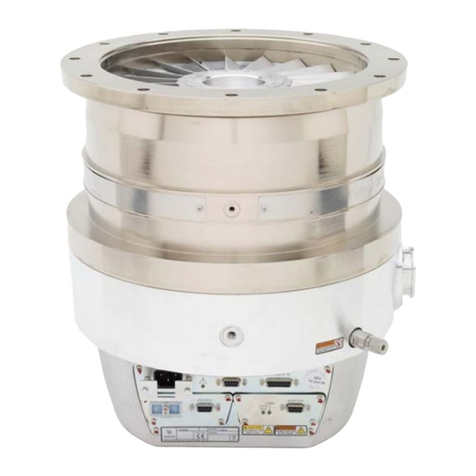
Agilent Technologies
Agilent Technologies Turbo-V 3K-G instruction manual

EBARA
EBARA SF6 Operating and maintenance manual

Veneroni
Veneroni AT Manual for use and maintenance
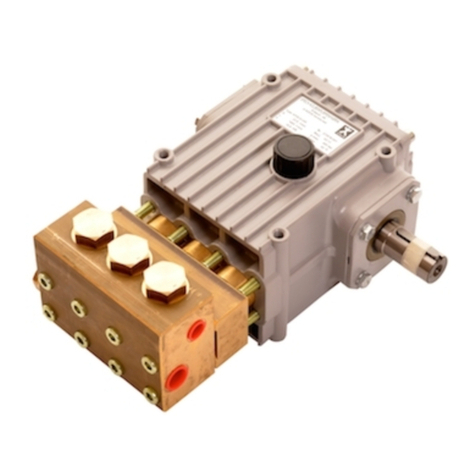
Speck
Speck NP25/11-500RKT operating instructions

T.I.P.
T.I.P. DHWA 4000/5 LED operating instructions

INOXPA
INOXPA ASPIR A-50 Installation, service and maintenance instructions

HP Autozubehor
HP Autozubehor 20260 quick start guide

Alemite
Alemite 9911-HA Service guide

Becker
Becker Picchio 2200 Maintenance Guide
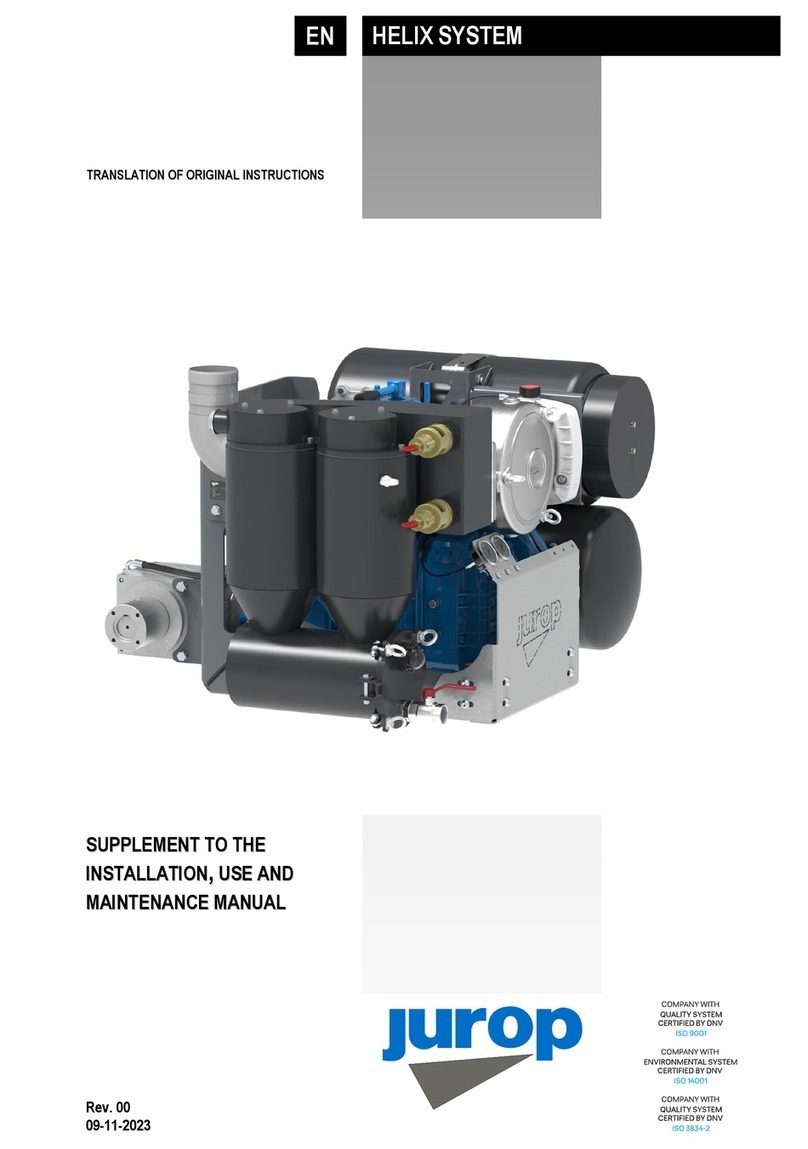
jurop
jurop HELIX 140 TRANSLATION OF ORIGINAL INSTRUCTIONS
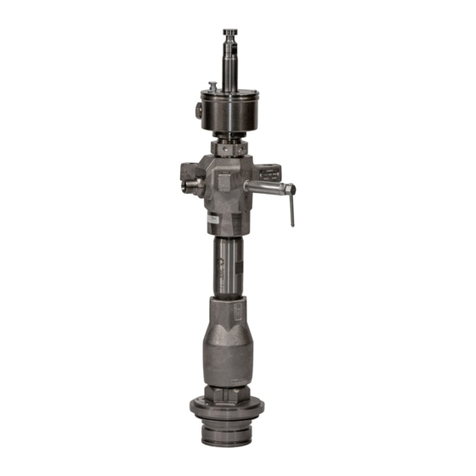
Graco
Graco Check-Mate L100CM Instructions - parts






